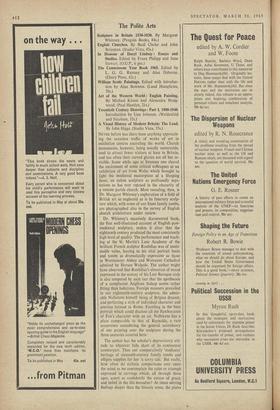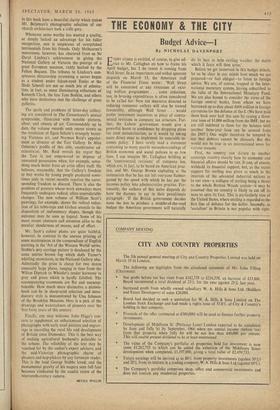The Polite Arts
Sculpture in Britain 1530-1830. By Margaret Whinney. (Penguin Books, 84s.) English Churches. By Basil Clarke and John Betjeman. (Studio Vista, 45s.) In Honour of Daryl Lindsay : Essays and Studies. Edited by Franz Philipp and June Stewart. (O.U.P., 6 gns.) The Connoisseur Year Book 1965. Edited by L. G. G. Ramsey and Alan Osborne. (Ebury Press, 42s.) Art of the Western World : English Painting. By Michael Kitson and Alexandra Wedg- wood. (Paul Hamlyn, 21s.)
NEVER before has there been anything approach- ing the ceaseless traffic of works of art in
exhibition centres encircling the world. Church monuments, however, being usually unmovable, tend to attract fewer visitors at least in Britain, and too often their carved glories are all but in- visible. Some while ago at Swansea one shared the excitement of some critical colleagues at an exhibition of art from Wales which brought to light the medieval masterpiece of a Sleeping Jesse, an oaken sculpture as profoundly mys- terious as has ever reposed in the obscurity of a remote parish church. Most revealing, then, is Dr. Margaret Whinney's exploration of a field of British art as neglected as is its funerary sculp- ture which, with some of our finest family tombs, are photographed also in the survey of English church architecture under review.
Dr. Whinney's massively documented book, the first well-illustrated account of English post- mediaeval sculpture, makes it clear that the eighteenth century produced the most consistently high level ,of quality. The performance and teach- ing at the St. Martin's Lane Academy of the brilliant French sculptor Roubiliac was of inesti- mable value, leaving us his vital portrait busts and tombs as dramatically expressive as those in Westminster Abbey and Worcester Cathedral admired by Horace Walpole. The author might have observed that Roubiliac's elevation of mood expressed in the ecstasy of his Late Baroque style is also tempered by such tact that the apotheosis of a complacent Anglican bishop seems rather fitting than ludicrous. Foreign manners prevailed in our eighteenth-century sculpture, the admir- able Nollekens himself being of Belgian descent, and perfecting a style of individual character and gravitas formed in Rome. Excelling in the bust portrait which could disclose all the flamboyance of Fox's character with an air, Nollekens has a place comparable to that of Reynolds, a rare occurrence considering the general ascendancy of our painting over the sculpture during the three centuries covered here.
The author has the scholar's depreciatory atti- tude to whatever falls short of its continental counterpart. Thus our comparatively 'mediocre' heritage of sixteenth-century family tombs and effigies supplies for her 'a sorry tale.' But really, how often do stylistic comparisons ever enter the mind as we contemplate the calm or triumph expressed in carvings which, all through these ages, assert so confidently the nature of grace, and belief in the life hereafter? At times stirring feelings deeper than the historic sense, the plates in this book have a beautiful clarity which makes Mr. Betjeman's photographic selection of our church architecture look a trifle grey.
Whenever some worthy has wanted a quality, or simply lacked an advantage for his fuller recognition, one is suspicious of overpitched testimonials from his friends. Only Melbourne's remoteness, however, has obscured from us Sir Daryl Lindsay's achievement in giving the National Gallery of Victoria the prestige of a great European museum, richly backed by the Felton Bequest. The tributes to Lindsay's con- spicuous directorship (crowning a career begun as a student under falcon-eyed Tonks at the Slade School) are not so much jets of admira- tion, in fact, as some illuminating reflections of Kenneth Clark, the late Tom Bodkin, and others who have themselves met the challenge of great galleries.
The spoils and problems of latter-day collect- ing are considered in The Connoisseur's annual symposium, illustrated with notable pictures, silver, and objects of art. Commendably up to date, the volume records such recent events as the revelation of Egon Schiele's strangely haunt- ing Viennese art, and Norman Reid's appoint- ment as director of the Tate Gallery. In Alan Osborne's profile of this able, unobtrusive ad- ministrator, Mr. Reid reveals his regret that the Tate is not empowered to dispose of unwanted possessions when, for example, some- thing much better from an artist offers itself. He believes, reasonably, that the Gallery's freedom to buy works by young people produced some- times only in recent months requires the corre- sponding freedom to discard. There is also the problem of painters whose work nowadays more frequently undergoes radical, often unpredictable changes. The new volume of William Scott's paintings, for example, shows the radical reduc- tion of his table-tops and kitchen utensils to the disposition of rudimentary shapes, though this outcome may be seen as logical. Some of his more recent abstracts call attention alike to the peculiar slenderness of means, and of effect.
Mr. Scott's colour plates are quite faithful, however, in contrast to the uneven printing of some masterpieces in the compendium of English painting in the 'Art of the Western World' series. Stubbs's airy carriage picture is deadened by the same untrue brown fog which dulls Turner's whirling snowstorm, in the National Gallery also. Admittedly the price is cheap for two dozen unusually large plates, ranging in time from the Wilton Diptych to Whistler's tender harmony in grey and green which is hardly falsified. The accompanying -comments are flat and unexcep- tionable. How much more distinctive a picture- book can be in sharp-eyed selection and intro- ductory style is demonstrated by Una Johnson of the Brooklyn Museum. Hers is a pick of the drawings and watercolours of pioneers over the first forty years of this century.
Finally, one may welcome John Higgs's con- cern to supplement an unhackneyed selection of photographs with early easel pictures and engrav- ings in recording the rural life and development of Britain since Domesday. This is the best way of making agricultural husbandry palatable to the urbane. The reliability of the text may be vouched for by the author's expert advisers, and the mid-Victorian photographic charm of gleaners and hop-pickers by any fortunate reader. This is the land George Stubbs loved, and the monumental gravity of his reapers seen full face becomes vindicated by the candid vision of the nineteenth-century camera.
NEVILE WALLIS















































 Previous page
Previous page